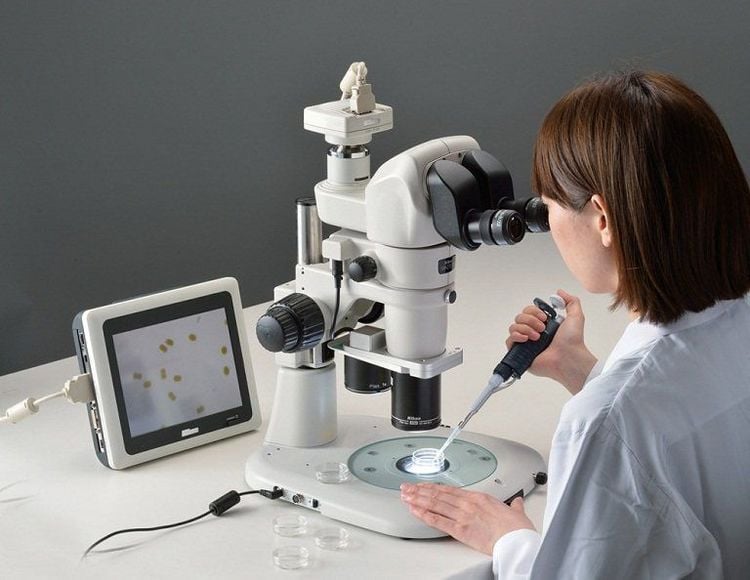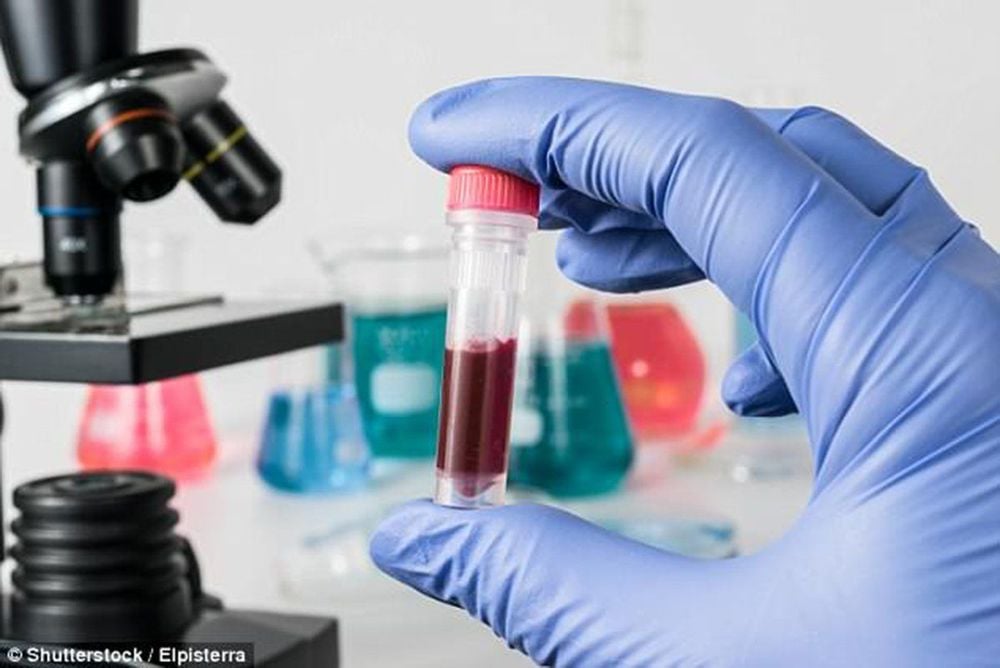This is an automatically translated article.
Endometrial cancer occurs in the cells in the endometrium and grows out of control. Endometrial cancer is often detected at an early stage because patients often have abnormal vaginal bleeding. If endometrial cancer is detected early and cured by hysterectomy.
1. Cancer imaging techniques in endometrial cancer assessment
Endometrial cancer is usually diagnosed after a woman goes to the doctor when she has unusual symptoms.
Ask about medical history and physical exam If you have any symptoms of endometrial cancer you should see your doctor right away. Your doctor will ask about your symptoms, risk factors, and medical history. In addition, the doctor will perform a general physical examination and a gynecological examination.
Ultrasound Ultrasound is often one of the first imaging techniques used to evaluate the uterus, ovaries, and fallopian tubes in women with gynecological problems. Ultrasound uses sound waves to take pictures of the inside of the body. The ultrawarmer uses a transducer that emits sound waves and captures the echoes as they bounce off organs. A computer is used to convert these echoes into images.
For pelvic ultrasound, the transducer is moved to the patient's lower abdomen. Usually, to get a good picture of the uterus, ovaries, and fallopian tubes, the bladder will need to stretch urine. That's why women, before having a pelvic ultrasound, will be instructed by the health care provider to drink plenty of water to empty their bladder.
Transvaginal ultrasound (TVUS) is a better imaging technique for looking directly at the uterus. For this technique, a TVUS probe (which works similarly to an ultrasound probe) is inserted into the vagina. Images from TVUS can be used to see if there is a tumor in the uterus, or if the endometrium is thicker than usual, it could be a sign of endometrial cancer. This diagnostic technique also evaluates whether cancer is growing into the muscular layer of the uterus (smooth muscle).
A small tube may be used to introduce saline (saline) into the uterus before the ultrasound. This helps the doctor see the lining of the uterus more clearly. This technique is called a saline infusion sonogram (SIS) or hysterosonogram.
Ultrasound can be used to evaluate endometrial polyps, measure the thickness of the endometrium, and from there, can help doctors pinpoint the exact area that needs to be biopsied.

Siêu âm âm đạo chẩn đoán ung thư nội mạc tử cung
Taking a sample of endometrial tissue To find out exactly what type of endometrial change is, the doctor must remove some tissue so it can be examined and looked at with a microscope. Endometrial tissue can be removed by endometrial biopsy or by dilation and curettage (Dilation and Curettage) with or without hysteroscopy. This technique is commonly performed by gynecologists with the procedure described below:
Endometrial biopsy Endometrial biopsy is the most commonly used test for endometrial cancer and provide highly accurate results in postmenopausal women. A very thin and flexible tube is inserted into the uterus through the cervix. Then, using suction, a small amount of the endometrium is removed through the tube. The suction process takes about a minute or less. You may experience discomfort that resembles menstrual cramps, and to relieve this symptom, your doctor will usually give you a non-steroidal anti-inflammatory drug (such as ibuprofen) before the procedure. Sometimes, a person will need an injection of a numbing medicine (local anesthetic) into the cervix before this procedure to relieve pain.
Hysteroscopy For this technique, the doctor places a small telescope (about 1/6 inch in diameter) into the uterus through the cervix. To get a better look at the inside (mucosa) of the uterus, the patient will be injected with saline into the uterus. This allows the doctor to look for and biopsy any tissue that shows abnormalities, such as cancer or polyps. Before performing this technique, usually the patient will be given a local anesthetic and during the procedure, the patient is fully awake.
Cervical dilation and curettage If the endometrial biopsy sample does not provide enough tissue or if the biopsy shows cancer but the results are not clear, the patient will need to perform additional cervical dilation technique uterus and curettage. In this technique, the cervix is dilated and the doctor inserts a special instrument into the uterus to scrape the tissue inside the uterus. This technique can be done in conjunction with hysteroscopy.
This technique takes about an hour and may require general anesthesia (medicine used to put you into a deep sleep) or sedation (medicine given into a vein to make you drowsy) or sedation Locally injected into the cervix or spine (or epidural). Cervical dilation and curettage are usually performed in the surgical area of a medical facility. Most women feel a little discomfort after performing this technique.
Endometrial tissue sample test Endometrial tissue samples are removed by biopsy or dilation and curettage and are examined microscopically for cancer. If cancer is found, the lab will tell you what type of endometrial cancer it is and the stage of the cancer.
Endometrial cancer is graded on a scale of 1 to 3 based on how well it compares to a normal endometrium. Women with low-grade cancer are less likely to have cancer in other parts of the body and are less likely to have cancer that comes back after treatment (recurrence).

Xét nghiệm mẫu mô nội mạc tử cung
Hereditary non-polyposis colon cancer If your doctor suspects that non-polyposis colon cancer is the cause of endometrial cancer, the tissue of the tumor may be examined for condition. protein and gene changes. Examples of changes associated with non-polyposis colon cancer include:
Few paired proteins Defects in paired genes DNA changes (called microsatellite instability or MSI) can occur occurs when one of the genes for non-polyposis colon cancer is faulty If there are changes in the protein or DNA, your doctor may order additional genetic tests for other genes that also cause colon cancer not due to polyps. Tests for low or unpaired protein levels showing MSI are often indicated in women who have been diagnosed with endometrial cancer at a young age or have a family history of endometrial cancer, or colon.
2. Diagnostic techniques to detect cancer metastasis
If the doctor suspects the cancer has progressed, the patient will have to perform other diagnostic techniques to check if the cancer has spread to other parts of the body and where it has spread.
Chest X-ray A chest X-ray may be done to help your doctor see if the cancer has spread to the lungs.
Computed tomography (CT) A CT scan is a procedure that uses X-rays to create detailed, cross-sectional images of the inside of your body. For a CT scan, you lie on a table during the scan. Instead of taking one picture like a standard x-ray, the CT scanner takes multiple pictures as it revolves around you. A computer then assembles these images into an image of a slice of the body. The machine will take pictures of multiple slices of the body part for the doctor to look at in more detail about the medical condition.

Chụp cắt lớp vi tính theo chỉ định của bác sĩ
A CT scan is not used to diagnose endometrial cancer, but the technique can help see if the cancer has spread to other organs and see if the cancer comes back after treatment.
Magnetic resonance imaging (MRI) An MRI scan uses radio waves and strong magnets instead of X-rays. Energy from radio waves is absorbed and then released in a pattern formed by the type of tissue and some sick. The computer then converts the radio wave pattern emitted by the tissues into detailed images of the inside of the body. This creates cross-sections of the body like a CT scanner, and it also creates slices parallel to the length of the patient's body.
An MRI scan is useful to look at the brain and spinal cord. Some doctors also think that an MRI is a good way to see how far endometrial cancer has spread. An MRI scan can also help find enlarged lymph nodes with a special technique that uses very small particles of iron oxide. They are inserted into a vein and deposited in the lymph nodes, where the iron oxide particles are then seen on an MRI image.
Positron emission tomography (PET) In this diagnostic technique, radioactive glucose (sugar) is used to look for cancer cells. This is because cancer uses glucose (sugar) at a higher rate than normal tissues, so radioactive glucose tends to accumulate in cancer cells. This diagnostic technique can be useful for detecting small subsets of cancer cells. A special scanner that combines PET scans with CT will pinpoint the exact areas where the cancer has spread. PET scans are not routinely indicated in the treatment of early endometrial cancer, but may be used in more advanced cases.
Cystoscopy and colonoscopy If a woman has problems that show cancer has spread to the bladder or rectum, the doctor can look directly inside these organs with a laparoscopy technique. In cystoscopy, the doctor inserts a tube with a camera from the urethra to the bladder. During a colonoscopy, this type of tube is inserted into the rectum. Both of these techniques allow the doctor to look for signs of cancer. During the procedure, your doctor may take a tissue sample for a biopsy. These two techniques can be performed using a local anesthetic, but some patients may need general anesthesia. These techniques have been used extensively in the past, but are now rarely used in the treatment of endometrial cancer.
Blood tests A complete blood count is a test that measures different cells in the blood, such as red blood cells, white blood cells, and platelets. Endometrial cancer can cause bleeding that results in a low red blood cell count (anemia).

Xét nghiệm máu nhằm đo các tế bào trong máu
CA-125 test: CA-125 is a circulating substance in many people with endometrial and ovarian cancer, but not everyone has it. If a woman has endometrial cancer, her blood CA-125 levels are very high, which means the cancer has likely spread outside the uterus. Some doctors check CA-125 levels before surgery or other treatment regimens or to evaluate the effectiveness of treatment. CA-125 levels are not needed to diagnose endometrial cancer, so not all patients have this test.
To meet the needs of women for gynecological cancer screening, Vinmec International Hospital currently offers a screening package and early detection of gynecological cancer, helping to detect 4 diseases early: Cancer cervical cancer, breast cancer, uterine cancer and ovarian cancer even if the patient has no symptoms.
The subjects who should use the Gynecological cancer screening and early detection package include:
Female customers, over 40 years old Customers wishing to be able to screen for pathology of breast-gynecological cancer (neck) uterus, uterus, ovaries) Customers with high risk of cancer – especially customers with a family history of breast cancer, gynecology Women of reproductive age, perimenopause Menopause and menopause Women are having symptoms of breast cancer, gynecology such as: pain in the breast, lump in the breast, bleeding outside the menstrual cycle, abdominal pain, etc... To register for an examination and treatment at Vinmec International General Hospital You can contact Vinmec Health System nationwide or register online HERE.
Please dial HOTLINE for more information or register for an appointment HERE. Download MyVinmec app to make appointments faster and to manage your bookings easily.
References: radiologyinfo.org, cancer.org SEE MOREEndometrial cancer: Symptoms, causes and screening Endometrial cancer detection and screening Premenopausal and postmenopausal bleeding Menopause: What you need to know













